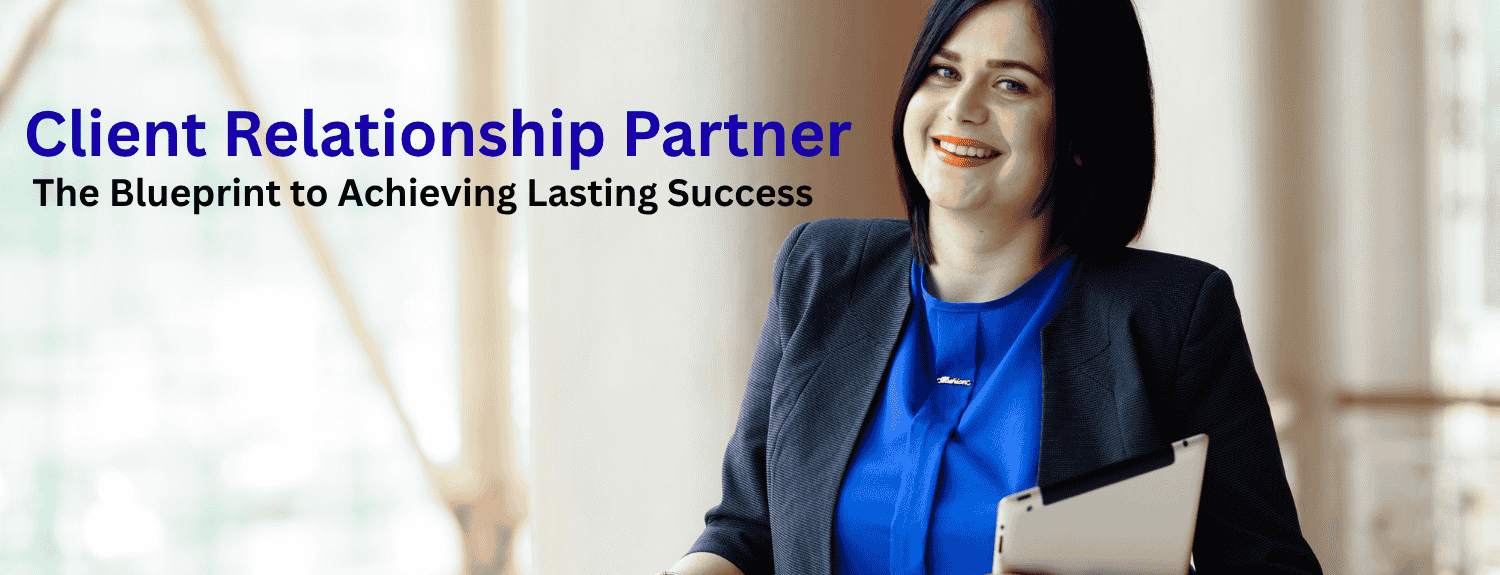Client Relationship Partner: The Blueprint to Achieving Lasting Success
For many professionals in client-facing roles, the week is a whirlwind of reactive tasks. A “fire” erupts, a missed deadline, a client complaint, a technical bug, and they spend their days as firefighters, dousing the flames just to get to the next crisis. They manage accounts, process requests, and handle problems.
There is a fundamental way to do it: Client Relationship Partner. It’s a new way of thinking, a philosophy of engagement.
This article provides the definitive blueprint to becoming an effective Client Relationship Partner. We will explore the mindset, the metrics, the essential skills, and the day-to-day responsibilities that separate a simple “account manager” from a true, indispensable “partner.”
What is a Client Relationship Partner?
A Client Relationship Partner (CRP) is more than an account manager or a customer service lead. They are the strategic visionary and primary custodian of trust for a company’s most important clients. They collaborate with the diner to understand their preferences, their dietary needs, and the event’s purpose, then design a custom menu that exceeds their expectations.
The CRP acts as the quarterback of the relationship. They are the single point of strategic contact, responsible for marshaling their company’s full resources from the C-suite to the product team, from support to finance, to ensure the client’s long-term success.
A CRP doesn’t wait for the client to report a problem. They are so deeply embedded in the client’s business that they can foresee challenges before they arise. They don’t wait for the client to ask about a new feature; they proactively bring strategic insights to the table, demonstrating how a new approach or product can help the client achieve a business goal they mentioned in a planning call three months ago.
Here is a simple breakdown of the key differences:
| Metric | Account Manager (Reactive) | Client Relationship Partner (Proactive) |
| Primary Focus | Daily operations, tasks, and problem-solving. | Long-term strategy, goals, and opportunities. |
| Key Question | “What do you need me to do today?” | “What are you trying to achieve this year?” |
| Mindset | Vendor / Supplier | Trusted Advisor / Strategic Partner |
| Communication | Reactive updates, status reports. | Proactive insights, strategic business reviews. |
| Value Prop | “I get things done for you.” | “I help you achieve your business goals.” |
| Relationship | Built with day-to-day users and contacts. | “Multi-threaded” across the organization, C-suite to C-suite. |

Why a CRP (Client Relationship Partner) is Your Business’s MVP
Hiring skilled Client Relationship Partners isn’t just a “nice to have”; it is a core driver of profitability and a powerful competitive advantage.
1. Protection Against Churn
Client Relationship Partners are the front line of defense against client churn. The data is overwhelming:
- Studies (like those from Bain & Company) show that increasing customer retention by just 5% can boost profits by 25% to 95%.
- It costs 5 to 25 times more to acquire a new customer than to retain an existing one.
A CRP builds relationships that are “poach-proof.” A competitor can always offer a 10% discount. But a competitor cannot replicate the two years of strategic trust, deep institutional knowledge, and personal rapport that a great CRP has built. They make switching more costly than staying.
2. The Engine for Growth
Loyal clients don’t just stay, they buy more.
- Existing customers typically spend 67% more than new buyers.
- The probability of selling to an existing, happy client is 60-70%, while the probability of selling to a new prospect is only 5-20%.
The CRP is perfectly positioned to identify these growth opportunities. Because they understand the client’s business goals, they aren’t “upselling”; they are prescribing the next logical solution to the client’s next big problem. This transforms an account from a static cost center into a dynamic, high-growth profit engine.
3. The Internal “Voice of the Customer”
A great CRP acts as an ambassador in both directions. They represent their company to the client, but just as importantly, they represent the client to their own company. They are the “Voice of the Customer” in product planning meetings, marketing discussions, and leadership strategy sessions. This invaluable, real-world feedback loop ensures the company’s products and services evolve to meet market demands, making them better and more competitive for everyone.
4. The Proactive Risk Mitigator
The CRP can sense a subtle shift in a client’s tone, notice a new executive has been hired in a key department, or get wind of a new budget constraint before it becomes a crisis. This foresight allows them to navigate these challenges calmly and strategically, turning potential crises into opportunities to build even more trust.
Measuring What Matters: The CRP’s Scorecard
To ensure client relationships are genuinely strong, CRPs and their organizations must move beyond simple “vibes” and track concrete metrics.
- Client Retention Rate (CRR): This is the baseline. The goal is typically 90-95% or higher in B2B. It answers the simple question: “Are our clients staying?”
- Net Revenue Retention (NRR) / Account Growth: This is the power metric. NRR measures total revenue from a cohort of clients, including upsells and expansion, while factoring out churn and contraction. A “good” NRR is over 100%, and a “great” NRR is 115-125%+. This shows that the relationship isn’t just stable; it’s growing and deepening.
- Net Promoter Score (NPS): This measures loyalty and the likelihood of referral. An NPS score above 50 is considered excellent and indicates that clients are active promoters of your brand. A CRP’s primary goal is to turn “Passives” into “Promoters.”
- Client Satisfaction (CSAT): This is often a more transactional, short-term measure (e.g., “How was your support experience?”). While less strategic than NPS, high CSAT scores are a leading indicator of overall relationship health. The aim is typically 4.5/5 or higher.
- Referral Generation / Client Referenceability: A key, often untracked, metric. A successful CRP should be able to ask, “Can I get 2-3 new referrals from this client per year?” Even more, they should cultivate the client into a reference who is willing to take a call from a prospect and sing your company’s praises. This is the ultimate proof of a partnership.
The Unspoken Metric: Beyond the spreadsheet, the real test is qualitative. Does the client call you for advice before they make a big decision in your area of expertise? Are you invited to their internal strategic planning sessions? If the answer is yes, you have successfully leaped, Partner.
The Anatomy of a World-Class CRP: Key Qualifications
The role of a Client Relationship Partner is demanding. It requires a unique blend of “soft” interpersonal skills and “hard” business acumen. These are the pillars of a successful CRP.
1. Radical Empathy:
This is the non-negotiable foundation. It’s not just “being nice.” It’s the ability to genuinely understand a client’s perspective, their pressures, and their personal career goals. A CRP who understands that their client contact is under pressure to impress a new boss will frame all solutions in a way that helps that contact look good and succeed personally.
2. Diplomatic & Translational Communication:
CRPs should be master communicators. They must be able to listen to a client’s vague business problem, translate it into a specific technical requirement for their internal team, and then translate the technical solution back into a simple, value-based business case for the client.
3. Forensic Problem-Solving:
A CRP goes to the root cause of the issue and fixes it promptly. When a problem arises, they use a “Five Whys” approach to dig deeper. They don’t just “resolve an issue”; they identify the systemic breakdown in process or communication that allowed the issue to happen and then lead the effort to fix it permanently.
4. ‘Over-the-Horizon’ Strategic Vision:
A great CRP lives in the client’s future. They read the client’s industry journals. They study the client’s competitors. They understand the macroeconomic trends affecting the client’s business. This allows them to bring new, unprompted ideas to the client, moving from a service provider to a genuine thought leader.
5. Commercial Acumen:
A CRP must understand how businesses run. They must be able to read a P&L statement, understand the client’s business model, and know how their own company makes money. This commercial awareness allows them to identify opportunities for mutual financial benefit and to frame their solutions in the language of ROI, not just features.
The 5-Step Roadmap to True Partnership
Becoming a successful Client Relationship Partner is a journey. Follow these five steps to move from a reactive vendor to a proactive partner.
1. Understand Client Needs (The Deep Dive)
You must understand the client’s business as well as they do. This means going beyond listening to requests. Ask better, deeper questions:
- What does success look like for your department this year?
- What keeps you up at night? What are the biggest risks to your business?
- Who are your biggest competitors, and what worries you about them?
- What are the key strategic initiatives your CEO just announced?
2. Build Trust and Transparency
Trust is the currency of all business relationships. You build it in small, consistent deposits over time.
- Radical Honesty: Be the first to admit a mistake. Don’t hide bad news. Call the client and say, “We missed a deadline. Here is exactly why it happened, here is our 3-point plan to fix it, and here is the measure I am personally putting in place to ensure it never happens again.” This builds more trust than a perfect record.
- Consistency: Do what you say you will do. Every time. Meet deadlines. Reply promptly. Be a reliable presence.
3. Deliver Consistent Value
Your job is to make your client more successful. Go beyond the Statement of Work (SOW).
- Share Proactive Insights: Send your client an article about a new trend in their industry.
- Be a Connector: Connect your client to a valuable contact in your network (e.g., a potential hire, another non-competing professional).
- Make Yourself a Resource: Become the person they call for an honest opinion, even on a topic not directly related to your service.
4. Focus on Retention and Loyalty
Retention is not passive; it is an active, daily effort. Make clients feel heard, valued, and important.
- Stay in Touch: Don’t just call when you need something or a project is due. Check in just to see how they are doing.
- Personalize: Remember the “human” details. Know their kids’ names, their favorite sports team, or that they just got back from vacation. Show you care about them, not just their account.
5. Measure and Improve
You cannot improve what you do not measure.
- Use Data: Track the metrics.
- Ask for Feedback: Don’t wait for an annual survey. After a major project, ask directly: “On a scale of 1-10, how did we do?” And the most important follow-up: “What is one thing we could have done to make that a 10?” This shows you are committed to continuous improvement.
Conclusion: The Connective Tissue of Modern Business
The Client Relationship Partner is a vital strategic leader in any company. This role adds value through strong client retention and account growth. The foundation is trust and personal connection.
This career blends strategic thinking, experience, and human skills like empathy and transparency. People who excel as CRPs help clients trust their company and grow together.
Becoming a Client Relationship Partner means shifting from reaction to proactive partnership. The rewards are lasting success both for the professional and the clients they serve.
FAQs
A CRP focuses on long-term strategic growth and acts as a trusted advisor. An Account Manager handles daily tasks and problem-solving.
By client retention, account growth, cross-selling, referrals, and longevity of client relationships.
Between 5 and 15 key accounts is typical, depending on industry complexity.
Strong communication, empathy, strategic thinking, industry knowledge, and problem-solving.
Satisfaction can improve in 3-6 months, but deep trust and business results take 12-18 months to develop.
Read Also:




Great article! I really appreciate the clear insights you shared – it shows true expertise & it will be invaluable for our business & marketing colleagues. Thanks for the valuable content!